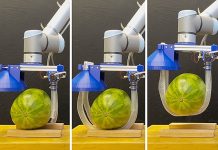
In a recent study, researchers have developed a new type of soft robot that is made and operated with no hard or electronic parts.
It has a soft, rubber computer that can tell the robot what to do. This is the first time that a robot can rely on soft digital logic exclusively.
Soft robots have played an important role in the metal-dominant world of robotics and they require simpler control systems.
For example, grippers made from rubbery silicone materials are already used in assembly lines to handle delicate fruit and vegetables like tomatoes, celery, and sausage links.
In laboratories, grippers can help pick up slippery fish, live mice, and even insects.
However, most soft robots still rely on some hardware.
In the current study, researchers have built a soft computer using just rubber and air. The soft computer using silicone tubing and pressurized air to mimic the input and output system in traditional computer systems.
They programmed the soft valves to react to different air pressures for complex operations—in this case, NOT, AND, and OR.
Their bobbing fish-like robot in the water tank uses an environmental pressure sensor (a modified NOT gate) to determine what action to take.
The robot can move flexibly. It dives when the circuit senses low pressure at the top of the tank and surfaces when it senses high pressure at depth.
The researchers suggest that soft robots can bring many benefits.
For example, in automobile factories, massive metal machines operate with blind speed and power.
If a human gets in the way, a hard robot could cause irreparable damage.
But if a soft robot bumps into a human, it will not cause injury or a catastrophic failure.
Soft robots are also generally cheaper and simpler to make than hard robots. They have lightweight, are resistant to damage and corrosive materials, and durable.
They can be very useful in situations when electronics struggle: High radiative fields like a nuclear malfunction and inside Magnetic Resonance Imaging (MRI) machines.
The rubber robots also offer an enticing possibility: Invisibility. If he chooses a material that camouflages in water, the robot would appear transparent when submerged.
The team hopes to create autonomous robots that are invisible to the naked eye or even sonar detection.
The lead author of the study is Daniel J. Preston, a postdoctoral researcher working with George Whitesides, the Woodford L. and Ann A. Flowers University Professor.
The study is published in PNAS.
Copyright © 2019 Knowridge Science Report. All rights reserved.



